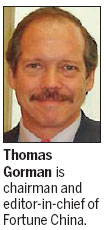Economy
Magazines eye business
Updated: 2011-05-13 10:30
By Karen Yip (China Daily European Weekly)
 |
|
A Beijing newsstand featuring Chinese editions of foreign magazines. Kevin Lee / Bloomberg |
Media bosses see potential for growth despite competition
Ask Thomas Gorman, the chairman and editor-in-chief of Fortune China magazine, which article he's most proud of and he'll say the cover story of the December 2010 issue.
It was an exclusive interview with Jim Collins, the acclaimed business guru and writer, who spoke to Chinese chief executive officers about leadership.
Released in 2001, Collins' business book entitled Good to Great was a hot item around the world, including its Chinese language edition.
Since the launch of the book, Gorman noted the number of Chinese mainland companies on the Fortune Global 500 list has increased from 10 to 42, in addition to an estimated 60 percent growth to 2,000 of Chinese companies listed on China's stock exchanges.
"Aside from distinguishing best practices to Chinese CEOs, we see such a story as engaging our readers and being relevant," he says.
Fortune China is circulated to senior managers in Chinese and international businesses and selected government officials in trade, finance and investment.
Engaging readers and being relevant seem more essential especially in an attractive market such as China, where the marketplace for magazines has grown exponentially.
Recalling when Fortune China was launched in 1996, Gorman says there were three business magazines then. "Today there are 150 (business) magazines."
But Fortune China is not perturbed. Why?
"Breaking news and market data are going to be owned online but magazines offer a particular niche in evolving business news. The tempo is different," he says.
From articles about General Electric, Siemens, or Nokia in the earlier issues of Fortune China, Chinese readers these days will find that the magazine's content has included management stories about leading Chinese companies.
"If you're standing still, you're going to fall behind. We're constantly aware of changes and that keeps us reformatting our offerings on what consumers need."
It has a robust online version that doesn't require subscription, targeted at a younger audience.
 |
In the media industry, Fortune journalists are known for spending two to three months to produce insights and depth along with great photos such as its April 2009 story on how Bernard Madoff pulled off his massive swindle worldwide. Telling photos of Madoff's rich and infamous lifestyle including his double life strengthened readers' visual understanding of the story.
The strong and attractive global brand of Fortune magazine helps too. Localizing the magazine without straying from its editorial core values and mission also sets Fortune China apart from its competitors.
Every year for 15 years, Fortune China has managed to increase its circulation with audited figures reaching 182,000 this year from 50,000 copies during its first year in China.
"Overall, there is a strong demand for foreign as well as local business magazines in China, and I don't see this changing," Gorman says.
In 2010, magazine revenue grew at 19 percent to reach $2.37 billion (1.67 billion euros), according to Beijing-based research firm CTR Market Research.
China's total advertising expenditure in 2010 rose 13 percent from a year ago. Although consumer price inflation may put pressure on the country's overall economic development in 2011, CTR says it is cautiously optimistic in forecasting that China's advertising market this year will continue to outpace gross domestic product growth at a rate of 15 percent.
There is room for further growth as advertising expenditure in magazines accounted for a mere 3 percent last year. However, the magazine business operates in a hyper-competitive market where advertising rates are being slashed indiscriminately.
Social buzz
A lot of foreign titles face a similar challenge in China. It doesn't help that a lot of advertising has moved to the Internet.
More and more advertisers are expected to take advantage of China's booming online market. Online advertising revenues are forecast to reach $6.95 billion by 2012 and become the second-largest media for advertising in the country, according to a recent report by the Data Center of China Internet.
"There are alternative media or platforms that offer their services and content at cheaper rates. That is competition for us," says Graham Davis, managing director, China and Japan, at The Economist Group.
"The online Chinese media is a big social buzz. China has jumped ahead of the rest of the world in terms of aggregator of news, advertisements and new ways of doing business."
Being realistic and not wanting to get caught up with the hype of doing business in China, he says the group is still at the drawing board, working on finding a suitable business model for The Economist magazine to be published in the Chinese language.
"We would love to do The Economist in Chinese. I believe China is going to be outward-looking and there will be strong demand for content such as that offered by us. It's an interesting market but we're not quite there yet.
"We're still thinking about what we can do. We know there's a reader base. The question is: How do we reach these readers? We could go print, online, digital, or form partnerships. But we don't know which way is the best," he says.
"At the moment we don't have clarity on the business model. We prefer to get things right. We're not in a hurry."
The Economist Group is one of very few media companies that reported strong profits, revenues and circulation growth from The Economist magazine and Economist.com during 2008 and 2009, the years when most news organizations hemorrhaged staff, closed bureaus, reduced coverage, went bust or dipped into the red.
The group's current contact with the Chinese market is from the Economist Intelligence Unit (EIU) based in Beijing. As a research and advisory firm, EIU charges premium fees to subscribers, who are mostly business leaders and decision-makers, for high quality information on economic and political forecasts, analysis and data covering 185 countries.
"The EIU content is loved by our Chinese business partners. My gut feeling is that there is a market demand for what we write. We're convinced that people want to read us," Davis says.
On censorship over issues deemed sensitive to China, The Economist magazine will stay faithful to its editorial values, he says.
"There is no easy solution and we do not self-censor. We just have to be conscious of the limitations when operating in China."
Right balance
There is very little that troubles Bloomberg LP. While news organizations are downsizing or worrying over new business models in a changing media landscape, Bloomberg is still hiring but never rehires those who quit, and remains electronic - certainly for the future.
To add to its astounding growth story, Bloomberg brought its monthly magazine to China last year.
"Working with our new China partner, Modern Media Holdings Limited, as well as our existing partner, CCTP, Bloomberg Businessweek/China will provide readers with Bloomberg's indispensable global business content as well as a significant amount of local coverage created with the growing Chinese business audience in mind," says Paul Bascobert, president of Bloomberg Businessweek.
Banking on analytics, data, news and information from 2,300 journalists worldwide, including more than 100 in China, Bloomberg Businessweek hopes to "provide the right balance for advertisers and readers", he says.
Modern Media Holdings Limited will manage and be responsible for the content of Bloomberg Businessweek/China, which will be published in Chinese.
Specials

The song dynasty
There are MORE THAN 300 types of Chinese operas but two POPULAR varieties are major standouts

Sino-US Dialogue
China and the US hold the third round of the Strategic and Economic Dialogue from May 9-10 in Washington.

Building communities
American architect John Portman and his company have developed more than 30 projects across China.